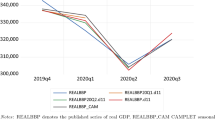Abstract
A typical problem of the seasonal adjustment procedures arises when the series to be adjusted is subject to structural breaks. In fact, using the full span of the series can result in a biased estimation of the “true” seasonally adjusted series, with unclear evidence showed by the usual diagnostic tests. In these cases the researcher has to decide where to cut-off the observed series to obtain a homogeneous span; this is generally performed by a simple visual inspection of the graph of the series and/or using a-priori information about the occurrence of the break. In this paper we propose a statistical criterion based on a distance measure between filters, evaluating its performance with Monte Carlo experiments.
Similar content being viewed by others
References
Andrews DWK (1993) Tests for Parameter Instability and Structural Change with Unknown Change Point. Econometrica, 61, 821–856.
Andrews DWK, Ploberger W (1994) Optimal Tests when a Nuisance Parameter Is Present only under the Alternative. Econometrica, 62, 1383–1414.
Bacchini F, Iannaccone R, Otranto E (2001) Model Stability and Model Based Seasonal Adjustment. In Modelli Complessi e Metodi Computazionali Intensivi per la Stima e la Previsione (Provasi C ed.), 57–62. Cleup, Padova.
Burman JP (1980) Seasonal Adjustment by Signal Extraction. Journal of the Royal Statistical Society, Ser. A 143, 321–337.
Chow G (1960) Test of the Equality between two Sets of Coefficients in Two Linear Regressions. Econometrica 28, 591–605.
Dagum EB (1988) Seasonal adjustment methods: foundation and user's manual. Statistics Canada, Ottawa.
Depoutot R, Planas C (1998) Comparing seasonal adjustment and trend extraction filters with application to a model-based selection of X11 linear filters. Eurostat working group document.
Findley D, Monsell B, Bell W, Otto M, Chen BC (1998) New Capabilities and Methods of the X-12-ARIMA Seasonal Adjustment Program. Journal of Business and Economic Statistics, 16, 127–152.
Fischer B, Planas C (2000) Large Scale Fitting of Regression Models with ARIMA Errors. Journal of Official Statistics 16, 173–184.
Ghysels E, Perron P (1993) The effect of Seasonal Adjustment Filters on Tests for a Unit Root. Journal of Econometrics 55, 59–99.
Ghysels E, Granger CWJ, Siklos PL (1996). Is Seasonal Adustment a Linear or Nonlinear Data-Filtering Process? Journal of the Business and Economic Statistics 14, 374–386.
Ghysels E, Perron P (1996) The effect of Linear Filters on Dynamic Time series with structural Change. Journal of Econometrics 70, 69–67.
Gómez V, Maravall A (1996) Programs SEATS and TRAMO: instructions for the user. Working Paper No. 9628, Bank of Spain.
Maravall A (1995) Unobserved Components in Economic Time Series. In The Handbook of Applied Econometrics, (Pesaran H, Schmidt P, Wickens M eds.), Vol. 1, 12–72. Basil Blackwell, Oxford.
McLeod AI, Li WK (1983) Diagnostic checking ARMA time series models using squared-residual autocorrelation. Journal of Time Series Analysis 4, 269–273.
Otranto E, Triacca U (2002) Measures to evaluate the discrepancy between direct and indirect model-based seasonal adjustment. Journal of Official Statistics 18, 511–530.
Piccolo D (1990) A distance measure for classifying ARIMA models. Journal of Time Series Analysis 11, 153–164.
Planas C (1998) Linear signal extraction with intervention techniques in non linear time series. Journal of Forecasting 17, 515–526.
Planas C, Depoutot R (2002) Controlling revisions in ARIMA-model-based seasonal adjustment. Journal of Time Series Analysis 23, 193–213.
Priestley MB (1981) Spectral analysis and time series. Academic Press, New York.
Author information
Authors and Affiliations
Corresponding author
Additional information
The first results of this work have been presented at the XL scientific meeting of the Italian statistical society, Florence, 26–28 April 2000, benefiting of the discussion arisen there; a preliminary version of this paper circulated as ISAE working paper No. 21/2001 with the title “The Choice of Time Interval in Seasonal Adjustment: Characterization and Tools”. We thank an anonymous referee for precious suggestions. The authors are solely responsible of any remaining error.
Rights and permissions
About this article
Cite this article
Bruno, G., Otranto, E. The choice of time interval in seasonal adjustment: A heuristic approach. Statistical Papers 47, 393–417 (2006). https://doi.org/10.1007/s00362-006-0295-x
Received:
Revised:
Issue Date:
DOI: https://doi.org/10.1007/s00362-006-0295-x




